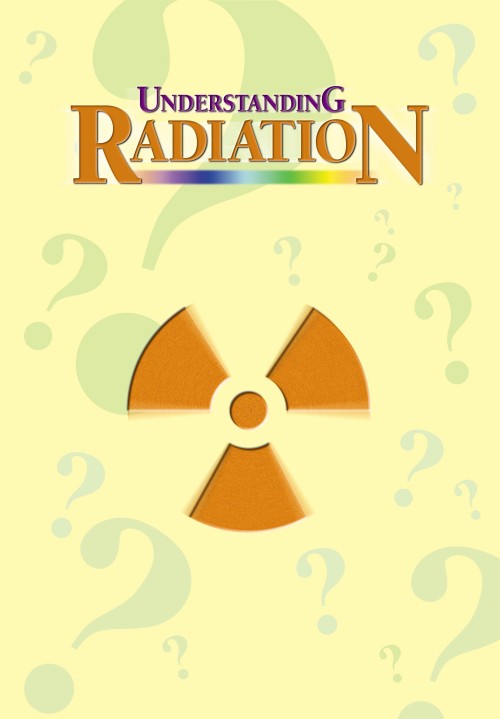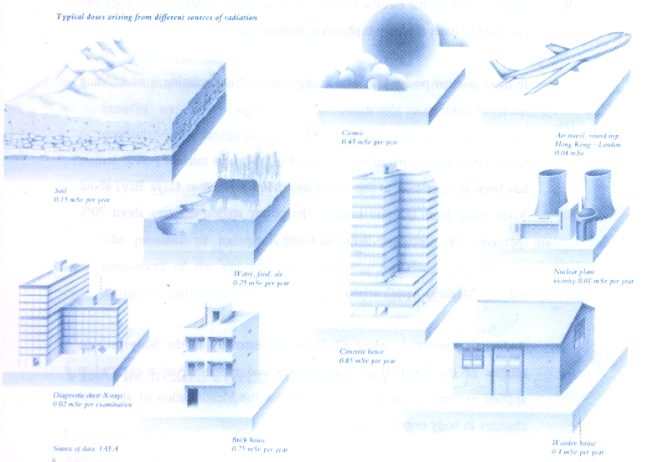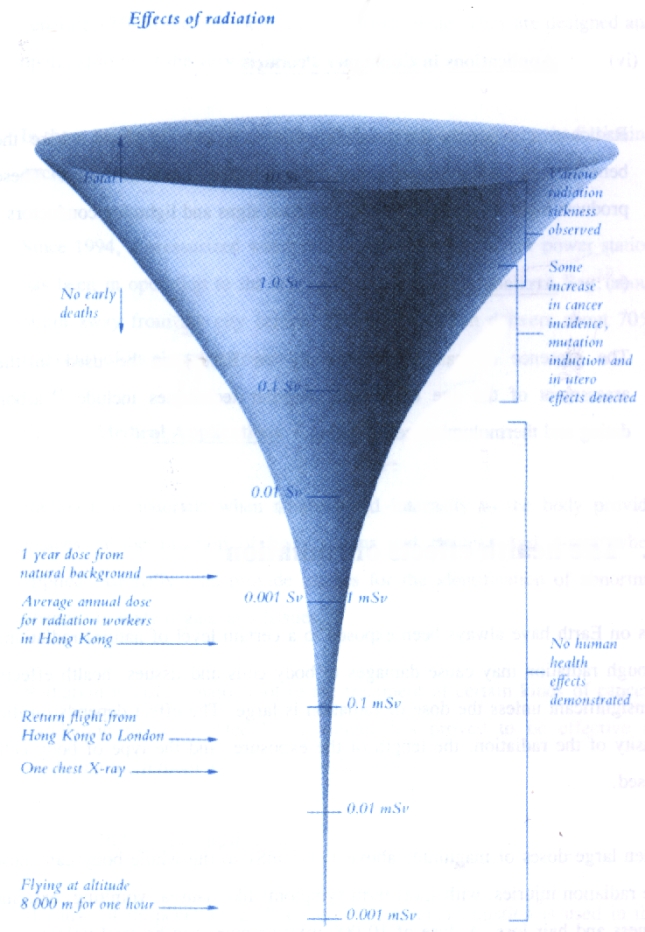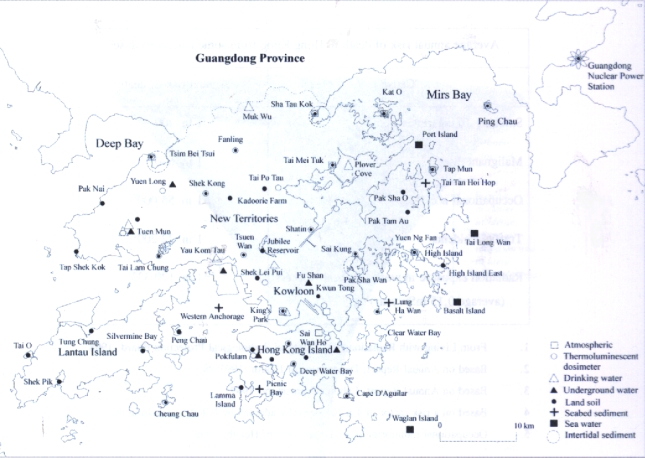Understanding Radiation

This booklet aims at providing you with basic information about atomic radiation and its applications, health effects and the programme of monitoring and control in Hong Kong. Introduction Radiation, and its effects, are a topic which arouses a great deal of concern and controversy - often without a proper understanding of all the facts. How much do we actually know about it? What is it? Where does it come from and how does it affect us? Matter is made up of tiny units called atoms. Every atom has a nucleus and a surrounding cloud of electrons. The nuclei of some atoms, like those of 40Potassium, are more unstable than others. They may change their structure and consequently their physical and chemical properties spontaneously. When an unstable nucleus undergoes changes, invisible particles or waves are released. The particles and waves are called radiation, the unstable nucle us is said to be radioactive. Radioactive nuclei are called radionuclides. The Universe is filled with radiation. Since the inception of time, lives on Earth have been exposed to radiation in the natural environment. Radiation cannot be felt, smelt, seen, heard or tasted. However, with the use of instrument, it can be detected and measured. The unit to measure radiation dose to tissues is sievert (Sv). One millisievert (mSv) is one-thousandth of a sievert. Radiation with energy high enough to remove electrons from an atom to create an electrically charged ion is called ionizing radiation. This ionization process often results in chemical changes in living tissue, which can lead to injury in the organism. Types of Ionizing Radiation The various types of ionizing radiation include :
The radioactivity of a material decreases with time. The time it takes for a material to lose half of its original radioactivity is its half-life. For example, 131 iodine has a half-life of 8 days. It loses half of its initial radioactivity in 8 days, and half of the remaining radioactivity in another 8 days, and so on. Each radionuclide has a characteristic half-life. The half-lives of various radionuclides may vary from millionths of a second to millions of years.
There are two generic sources of radiation - natural and artificial. (i) Natural Radiation We are continuously exposed to cosmic ray from space and the radiation emitted by radioactive substances that exist in everything on Earth, including our food and habitat. Natural radiation accounts for about 80% of the radiation doses to which we are subjected. It may vary from place to place. (ii) Artificial radiation Radiation has many useful applications in medicine. These include x-ray radiology, nuclear medicine imaging and radiation therapy. Medical use of radiation is the most significant source of human-made radiation. Other major artificial sources of radiation exposure are radioactive fallout from nuclear testings, x-ray emission from vacuum tubes, such as television and video display units, and use of radioactive materials in consumer products, such as radioluminous articles and smoke detectors. Air travelling enhances our exposure to cosmic ray and living indoor enhances our exposure to radon, which is a radioactive gas from the decay of radium in terrestrial materials. 
Put to proper use, radioactive substances and radiation can be used to the benefits of the society. (i) Electricity Generation The demand for energy increases with the world's booming population and expanding economy. We are consuming energy at a pace much faster than the Earth can replenish it. Nuclear energy is a source to meet this ever increasing demand of energy. To date, there are over 430 commercial nuclear power reactors in operation around the world. These reactors generate 17% of the electricity demand world-wide. They are designed and operated to meet the very high safety standards. In these nuclear power reactors, energy comes from splitting, or fissioning nuclei of uranium or plutonium. Since 1994, a pressurized water reactor (PWR) type nuclear power station has been in operation to the northeast of Hong Kong at Daya Bay, about 50km away from the city centre. The power station delivers about 70% (percent) of its electricity output to Hong Kong. (ii) Medical Applications Radioactive materials when administered internally to the body provide images of the function of body organs and tissues. And x-ray, when applied externally, can provide images for the identification of abnormal changes in body organs and tissues. Radiation is also a major tool in the treatment of certain kinds of cancer. Irradiating tissue affected by a tumour has proved to be effective in inhibiting the tumour's growth or in destroying it. (iii) Industrial Applications Because of its penetrating characteristics, gamma radiation is used in the imaging of defects in welds and metal castings. Radiation is widely used to provide automatic quality adjustments in production lines, such as the gauging of level in beverage cans or density of tobacco in cigarettes. It is also used to measure the thickness of electroplating and to eliminate static charges in industries, for example, in the manufacture of electronic components. (iv) Applications in Consumer Products Radioactive materials are used in some consumer products where the benefits and safety significantly outweigh the radiation risks. These products include smoke detectors, luminous signs and lightning conductors. (v) Archaeological Application The presence of natural radioactivity on Earth can be used in the assessment of the age of objects. Popular techniques include 14carbon dating and thermoluminescence dating. VI. The health effects of radiation Lives on Earth have always been exposed to a certain level of natural radiation. Although radiation may cause damages to body cells and tissues, health effects are insignificant unless the dose of radiation is large. The effect depends on the intensity of the radiation, the length of the exposure, and the type of body cell exposed. Sudden large doses of magnitude above 1 000 mSv to the whole body can cause acute radiation injuries, with short-term symptoms like nausea, vomiting, extreme tiredness and hair loss. Above whole body radiation dose of 10 000 mSv, death is most likely even with medical treatment. 
Besides, exposure to radiation can increase the risks of cancers to the exposed individuals and genetic defects to their offspring. Radiation dose received by the general public in daily life are very low. Even for workers who are exposed to radiation in their work, the expected radiation induced mortality rate is small when compared with some common causes of death as shown in the table below :
1. From Living with Radiation, UK, National Radiological Protection Board, 1998 2. Based on Annual Report, Department of Health, 1997/98 3. Based on Annual Report, Labour Department, 1997 4. Based on a risk factor of 4 x 10-5 per mSv adopted by ICRP, publication 60, 1990 5. Occupational monitoring data, Department of Health, 1998 VII. Environmental radiation monitoring programme in Hong Kong From 1987 to 1991, the Hong Kong Observatory conducted a comprehensive radiation monitoring programme to establish the baseline radiation levels in various environmental media in Hong Kong. These levels are compared with those obtained after the Guangdong Daya Bay Nuclear Power Station was put in commercial operation in 1994. In the programme, samples of air, water, foodstuff, soil and the like are collected and analyzed for their radioactivity content. Environmental gamma radiation levels were also measured. The measurement results show that there is no observable increase in the radiation level in the environment of Hong Kong. Details of measurements are published in the monthly and annual reports of the Hong Kong Observatory. 
The import, export, possession and use of radioactive substance and irradiating apparatus in Hong Kong is governed by the Radiation Ordinance (Cap 303), Laws of Hong Kong, which provides for the establishment of the Radiation Board. A licence from the Board is required for any person to carry out any activity involving radioactive substance or irradiating apparatus. The Radiation Health Division of the Department of Health serves as the licensing office of the Radiation Board. The division also serves as Government's adviser on radiation health matters, provides occupational and environmental radiation monitoring services, and maintains the radiation metrology standards of Hong Kong. You are welcome to contact the Radiation Health Division of the Department of Health at Tel. no. 2886 1551, Fax no. 2834 1224, or visit the websites of the Department of Health, https://www.rhd.gov.hk and the Hong Kong Observatory , http://www.info.gov.hk/hko for more information. |
|||||||||||||||||||||||||||||||||||